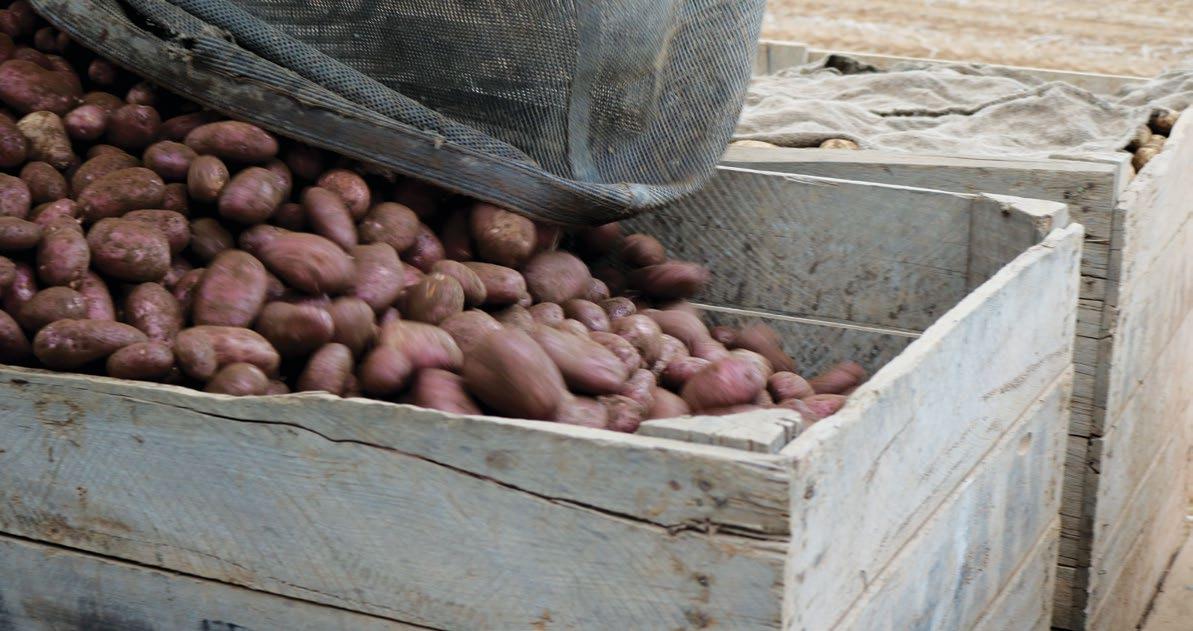
9 minute read
Powdery scab in potatoes
Managing the risks of powdery scab in potatoes Spongospora subterranea
This guide is based on dry rot (Fusarium caeruleum) and current knowledge on tuber rot caused by Colletotrichum management of powdery atramentarium. scab, highlighting key factors What does it look like? that affect the risks of this • Spongospora subterranea can form small white to dark brown growths disease and opportunities for (galls) on potato roots and stolons (see effective disease management. Figure 1).
Advertisement
What is powdery scab? • Scabs on tubers erupt to disperse a
Powdery scab is caused by Spongospora subterranea. This fine powder of spores leaving ragged edged scabs (see Figure 2). pathogen can survive for long periods • Non-erupting scabs may develop in the soil (greater than 10 years). surrounding areas of discoloured tuber
The pathogen is both seed tuber tissue which is variable in size. and soil borne. Disease • Depending on temperature and development and the progeny, tuber scabs may take severity of symptoms vary depending on a range of factors, including inoculum Spongospora subterranea can survive more than six to eight weeks to develop, and may not be evident in growing crops. levels in soil or on seed 10years in the soil. • Common scab and tubers, soil and atmospheric powdery scab lesions look conditions, cropping history, similar. Common scab and potato cultivar. lesions tend to be more
The disease can cause major corky in appearance and angular in shape, and can be raised or pitted. losses of marketable yield from • Cankers may deform tubers. fresh market potato crops, and Factors that encourage substantial rejections in processing Spongospora infections for French fries or crisp production. Potato crops are especially susceptible to powdery scab:
Tubers with powdery scab lesions are • During the tuber initiation phase of also susceptible to other diseases. crop growth.
The scab lesions can be infection points for other pathogens, and powdery scab has been implicated in • When temperatures are between 9°C and 17°C (optimum is approx. 12°C). increasing susceptibility to tuber late • When soils are wet. blight (Phytophthora infestans), pink • In poorly drained soils (due to rot (Phytophthora erythroseptica), compaction, soil pans or over-working).
62
FIGURE 1. SPONGOSPORA SUBTERRANEA GALLS ON STOLON.

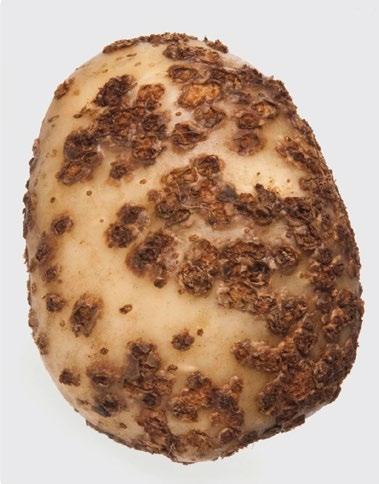
FIGURE 2. RAGGED EDGED SCABS ON TUBER.
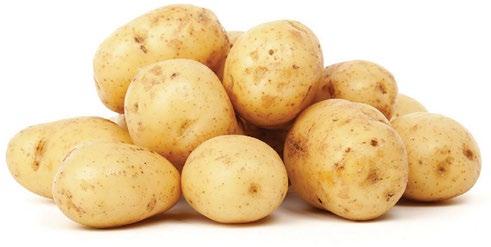
FIGURE 3. DIAGRAM OF THE SPONGOSPORA SUBTERRANEA LIFE AND DISEASE CYCLE. Source: Harrison JG, Searle RJ, Williams NA, 1997. Powdery scab disease of potato – a review. Plant Pathology 46, 1–25
Cystosori (spore balls)
Scabbed tuber Cyst in soil or on tuber
Cysts (resting spores) Root, shoot or stolon infection
Galls Lesion (scab)

Galls on root, shoot or stolon Primary zoospore
Root hair infection
Plasmodium in root hair (primary or sporangial plasmodium)
Zoosporangia in root hair
Plasmodium in tuber cell (secondary or cystogenous plasmodium) Tuber infection Secondary zoospore
How can the risk of powdery scab be reduced?
1
Site selection and farm hygiene
Risks · Previous field history of powdery scab. · Volunteers. · Solanaceous weeds. · Poor drainage. · Rotation.
Actions to manage the risk · Consider paddock disease history when developing a rotation plan. Use
PreDicta® Pt DNA testing to assess risks from pathogen levels in the soil. · Avoid short rotations (less than five years) between potato crops. · Control volunteers and weeds to minimise pathogen build-up. · Plant at soil temperatures above the optimum (12°C) for infection. This results in rapid plant growth and less chances for infection. · Plant high risk crops (based on varieties or market) on uncontaminated and well-drained land. · Use uninfected, certified seed tubers. · Do not transfer soil from paddock to paddock. · Do not allow contractors and visitors with dirty machinery, shoes and vehicles onto paddocks.
2
Soil conditions
Risks · Cold, wet soils (particularly at tuber initiation). · Soil compaction. · Excessive cultivation/tillage. Actions to manage the risk · Avoid soils that are compacted (>2,000kPa with a penetrometer at field capacity), and try to control traffic through paddock. · Use of elemental sulphur (S) and maintaining zinc (Zn) at the upper end of its soil range have reduced powdery scab in the Ballarat region of
Central Victoria. — Results with Zn applications have been highly variable. Routine soil testing will indicate whether Zn fertiliser applications may help. High levels of phosphorus can reduce Zn uptake. — Caution with S use is required as applications may cause nutrient imbalances and significant decreases in soil pH. · Biofumigation using mustards has shown positive results when combined with less susceptible cultivars and clean seed tubers. · Drain paddocks that have large areas prone to water logging. · Ensure good seed beds to promote rapid and even plant emergence.
3
Crop growth
Risks · Protracted tuber initiation periods in cold soils containing either seed or soil inoculum. · Over irrigation and/or poor drainage during tuber initiation. Actions to manage the risk · Manage nutrition appropriately. · Schedule irrigation correctly to avoid water logging and water stress (especially during tuber initiation). · Be aware that the risk of powdery scab will increase after excessive rainfall. · Planting tubers at shallow depth in the ridges may help reduce risk, as do other practices that encourage rapid plant emergence. · Monitor soil moisture and keep it below field capacity (FC) during tuber initiation. If water runs from soil after irrigation or can be squeezed out of a soil sample, the soil is above FC.
4
Potato grading
Risk · Inoculum can contaminate grading lines and be transmitted to subsequent healthy seed tuber lines, which could infect the subsequent crop.
Actions to manage the risk · Wash and evaluate samples of all seed tuber lines intended for grading to assess whether they are infected. · Grade seed tubers before fresh market lines. Give priority to higher seed grades. · Wash/disinfect grading lines at appropriate times during grading and between lines/crops. · Fully wash down and disinfect grading lines at the end of each season (at least). · Removing infected tubers from seed lines does little to diminish the risk for remaining tubers, as resting spores will contaminate remaining tubers.
Cultivar/variety
Risk · Highly susceptible cultivars. Actions to manage the risk Check cultivar resistance to powdery scab with your seed tuber supplier. · Knowing cultivar resistance ratings for powdery scab along with intended market tolerances can help with paddock selection and crop management (esp. irrigation). · Resistant cultivars can be used to reduce occurrence and severity of powdery scab. However, in seasons conducive to disease development, cultivar resistance will have reduced impacts. · Refer to the research paper written by Genet et al. which provides a list of over 130 cultivars and their resistance/ susceptibility to powdery scab.
Seed tuber health
Risk · Infected seed lines, particularly when planted in uncontaminated land. Actions to manage the risk · Use certified disease-free seed tubers when planting into uncontaminated land.
Store hygiene
Risk · Dust in potato stores can be contaminated with Spongospora inoculum. This can be transmitted on to clean tubers in poorly cleaned stores (e.g. by forklift traffic). Actions to manage the risk · Ensure strict store hygiene is in place with your seed supplier.
8
Market
Risk · Markets with zero tolerance for powdery scab, e.g. for particular seed export or fresh/ware potato markets. Actions to manage the risk · Check your customer/intended market tolerance to powdery scab levels.
Use low risk land for markets with tight tolerances. · Wash seed tuber samples and inspect as required.
9
Chemical control
In the USA and New Zealand, fluazinam can be used for powdery scab control. In Australia, this chemical is only registered for control of late blight and Sclerotinia in potatoes. Do not use unregistered pesticides or use pesticides for uses not specified on the labels. Always follow label instructions.
REFERENCES AND FURTHER RESOURCES
• Potato Growers’ Biosecurity Manual (2018) www.farmbiosecurity.com.au/wpcontent/ uploads/2019/06/Potato-Growers
Biosecurity-Manual.pdf • Prof Calum Wilson (TIA, UTAS) discussing powdery and common scab — video https://youtu.be/ryHPrvWcF8o • Falloon, R.E., Merz, U., Butler, R.C.,
Curtin, D., Lister, R.A., Thomas, S.M., 2016. Root infection of potato (Solanum tuberosum) caused by Spongospora subterranea: knowledge review and evidence for decreased plant productivity.
Plant Pathology 56, 422–434. https:// bsppjournals.onlinelibrary.wiley.com/doi/ full/10.1111/ppa.12419 • Genet, R., Paget, M., Braam, F., Falloon,
R., 2017. Susceptibility of potato cultivars and breeding lines to powdery scab in New
Zealand: updated results from 25 years of field evaluations. Potato Research 60, 208–210. www.spongospora.ethz.ch/SA_2014/ docus/day2/2nd%20Int%20PScab%20
Workshop%203_%20Genet%20et%20al.pdf • 2013 Potato PreDicta ® Pt manual (ed.
M Rettke, SARDI) [provided as part of
Predicta ® Pt Training/Accreditation Course] A number of relevant final reports can be found on the AUSVEG website (https://ausveg.com. au/infoveg/infoveg-database/) and the Hort Innovation website (www.horticulture.com. au/delivery-partners/resources-for-deliverypartners/research-reports-and-more). 1996 PT303 Epidemiology and control of powdery scab in potatoes https:// ausveg.com.au/app/data/technicalinsights/docs/PT303.pdf 2003 PT96032 Influence of rotation and biofumigation on soil-borne diseases of potatoes https://ausveg.com.au/app/ data/technical-insights/docs/PT96032. pdf 2004 PT98018 Cleaning and disinfestation strategies on farms https://ausveg.com. au/app/data/technical-insights/docs/ PT98018.pdf 2008 PT04001 Understanding the implications of pastures on the management of soilborne diseases of seed potatoes https:// ausveg.com.au/app/data/technicalinsights/docs/PT04001_complete.pdf 2014 PT09039 (https://ausveg.com.au/app/ data/technical-insights/docs/PT09039. PDF) which includes the following APRP2 programs: PT09026 — Soil health disease mitigation program, PT09026A(i) — Soil amendments and nutrients, PT09026(ii) — Impact of rotations, PT09019 — Comparison between DNA testing and visual methods for assessing seed tuber health 2018 PT14002 Spongospora infection of potato roots — ecology, epidemiology and control https://ausveg.com.au/app/ uploads/technical-insights/PT14002v2. pdf
ACKNOWLEDGEMENTS
This article has been adapted from: • Managing the risk of powdery scab (2007)
Mark Prentice, Rob Clayton, Jeff Peters and
Stuart Wale. British Potato Council • A review of knowledge gaps and compilation of R and D outputs from the Australian
Potato Research Programs (2015) Kevin
Clayton-Greene. Horticulture Innovation
Australia (https://ausveg.com.au/app/data/ technicalinsights/docs/pt13.PDF).
DISCLAIMER
Hort Innovation and RM Consulting Group (RMCG) make no representations and expressly disclaims all warranties (to the extent permitted by law) about the accuracy, completeness, or currency of information in this article. Users of this material should take independent action before relying on it’s accuracy in any way. Reliance on any information provided by Hort Innovation and RMCG is entirely at your own risk. Hort Innovation and RMCG are not responsible for, and will not be liable for, any loss, damage, claim, expense, cost (including legal costs) or other liability arising in any way (including from Hort Innovation, RMCG or any other person’s negligence or otherwise) from your use or non-use of information from project PT17002 — Potato pest and disease R&D program or from reliance on information contained in this material or that Hort Innovation, RMCG provides to you by any other means.
Victoria Baker Photographer PHOTOS:
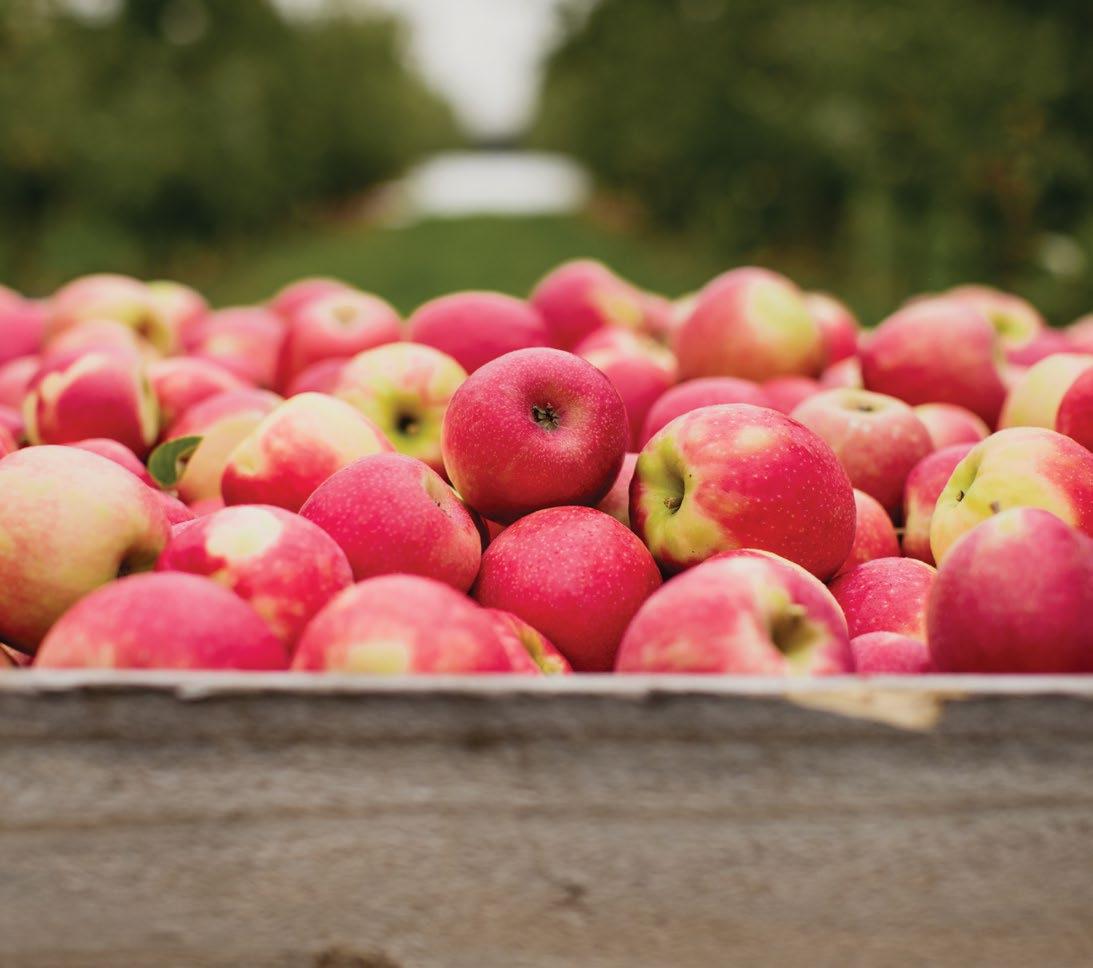

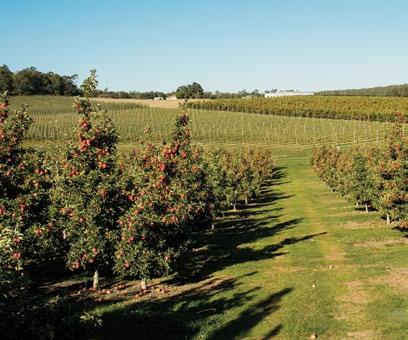
update pome












